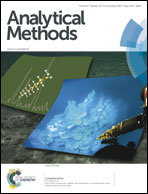Water-soluble pyridine-based colorimetric chemosensor for naked eye detection of silver ions: design, synthesis, spectral and theoretical investigation†
Abstract
A water soluble pyridine containing a Schiff base as chemosensor was designed and then synthesised. The chemosensor (L) was synthesized by reacting pyridoxal and 2-aminoethanol and then comprehensively characterized using elemental analysis, spectroscopic methods (infrared, ultraviolet-visible, nuclear magnetic resonance (1H-NMR and 13C-NMR) spectroscopy), electrospray ionization mass spectroscopy, and single crystal X-ray crystallography. The designed compound showed excellent specificity and sensitivity (detection limit = 4.18 × 10−6 M) towards Ag+ ions in preference to other interfering cations (Ca2+, Co2+, Cu2+, Fe2+, Fe3+, Hg2+, VO2+, K+, Li+, Mn2+, Na+, Ni2+, Pb2+ and Zn2+) in aqueous solution. The (L) showed a selective chromogenic behavior towards Ag+ ions by changing the color of the solution from light yellow to red, a change which can be detected with the naked eye. A simple and cost effective test kit was prepared for the detection of silver ion in water samples. Time-dependent density functional theory calculations were carried out to help understand the sensing mechanism.


 Please wait while we load your content...
Please wait while we load your content...